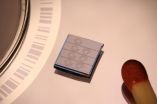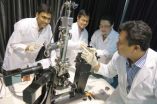(Press-News.org) Scientists at Umeå University in Sweden have found that carbon dioxide, in its ionic form bicarbonate, has a regulating function in the splitting of water in photosynthesis. This means that carbon dioxide has an additional role to being reduced to sugar. The pioneering work is published in the latest issue of the scientific journal PNAS.
It is well known that inorganic carbon in the form of carbon dioxide, CO2, is reduced in a light driven process known as photosynthesis to organic compounds in the chloroplasts. Less well known is that inorganic carbon also affects the rate of the photosynthetic electron transport and thus the rate of photosynthetic oxygen production. This result was first published by the Nobel Prize winner Otto Warburg and his collaborator in the late 50s.
Their explanation for the stimulating effect was logical at that time since they proposed that carbon dioxide was the source of the oxygen that plants produce. Their idea was proven to be incorrect many years later and instead we now know that water, H2O, is the source of oxygen in the atmosphere.
The observed stimulating effect by inorganic carbon on photosynthetic electron transport, has continued to cause an inflammatory debate among photosynthetic researchers around the world and resulted in hundreds of papers published on this issue.
"Our results will now put an end to this debate," says Johannes Messinger, Professor at the Department of Chemistry.
His research group has developed a very sensitive techniques based on "Membrane Inlet Mass Spectroscopy" that can be used to measure the production of gases in photosynthetic samples under analytically controlled conditions.
With this sensitive method they were able to test an earlier hypothesis that bicarbonate is acting as an acceptor for the protons that are produced when water is split in photosystem II. If so, a light driven production of carbon dioxide in addition to oxygen should be detected.
To their delight, the scientists could detect relatively large amounts of carbon dioxide in the mass spectrometric experiments.
"Therefore, it seems as if two different carbon species, both derived from the carbonic acid cycle, have got the optimal chemical properties to be used as terminal electron acceptor (CO2) in the very end of the photosynthetic reaction and at the same time as proton acceptor (HCO3-) in the very beginning of the photosynthetic reaction", says Johannes Messinger.
The results open up a new research field where researchers can investigate possible biological and ecological consequences of the dual role of carbon dioxide.
About Artificial photosynthesis:
In the search for a clean and renewable energy source researchers at Umeå University are studying photosynthesis with the purpose to create artificial photosynthesis devices. Their aim is to understand and model the complex reactions that take place in plant chloroplasts during photosynthesis in order to mimic natural photosynthesis in an "artificial leaf", an integrated unit that connects all important processes. If successful, it will be possible to convert sunlight directly into environmentally friendly energy carriers, for example into hydrogen gas.
INFORMATION:
http://www.solarfuels.se
Pioneering findings on the dual role of carbon dioxide in photosynthesis
2014-04-14
ELSE PRESS RELEASES FROM THIS DATE:
The result of slow degradation
2014-04-14
This news release is available in German. Although persistent environmental pollutants have been and continue to be released worldwide, the Arctic and Antarctic regions are significantly more contaminated than elsewhere. The marine animals living there have some of the highest levels of persistent organic pollutant (POP) contamination of any creatures. The Inuit people of the Arctic, who rely on a diet of fish, seals and whales, have also been shown to have higher POP concentrations than people living in our latitudes.
Today, the production and use of nearly two dozen ...
Nutrient-rich forests absorb more carbon
2014-04-14
The ability of forests to sequester carbon from the atmosphere depends on nutrients available in the forest soils, shows new research from an international team of researchers including the International Institute for Applied Systems Analysis (IIASA).
The study showed that forests growing in fertile soils with ample nutrients are able to sequester about 30% of the carbon that they take up during photosynthesis. In contrast, forests growing in nutrient-poor soils may retain only 6% of that carbon. The rest is returned to the atmosphere as respiration.
"This paper produces ...
Scientists open door to better solar cells, superconductors and hard-drives
2014-04-14
Using DESY's bright research light sources, scientists have opened a new door to better solar cells, novel superconductors and smaller hard-drives. The research reported in the scientific journal Nature Communications this week enhances the understanding of the interface of two materials, where completely new properties can arise. With their work, the team of Prof. Andrivo Rusydi from the National University of Singapore and Prof. Michael Rübhausen from the Hamburg Center for Free-Electron Laser Science (CFEL) have solved a long standing mystery in the physics of condensed ...
Combs of light accelerate communication
2014-04-14
This news release is available in German.
Miniaturized optical frequency comb sources allow for transmission of data streams of several terabits per second over hundreds of kilometers – this has now been demonstrated by researchers of Karlsruhe Institute of Technology (KIT) and the Swiss École Polytechnique Fédérale de Lausanne (EPFL) in a experiment presented in the journal Nature Photonics. The results may contribute to accelerating data transmission in large computing centers and worldwide communication networks. (DOI: 10.1038/NPHOTON.2014.57.)
The amount of ...
Proteomics International biomarker study closer to a CDx test for diabetic kidney disease
2014-04-14
April 2014, Perth, Australia. Drug discovery company Proteomics International has completed an important milestone towards the development of a companion diagnostic (CDx) test with the validation of several of its protein biomarkers.
The research team authenticated the panel of biomarkers after taking 508 highly curated disease and control samples. Seven biomarkers were validated at high stringency using the company's proprietary mass spectrometry approach.
The mass spectrometry data was then cross-validated using immunoassays in collaboration with the KTH Royal Institute ...
Beneficial organisms react differently to parasite drug
2014-04-14
The substance ivermectin has been used for more than thirty years all over the world to combat parasites like roundworms, lice and mites in humans, livestock and pets. The active ingredient belongs to the chemical group of avermectins, which generally disrupt cell transport and thus attack pests. When ivermectin is excreted in the faeces of treated animals, at overly high doses it also harms dung-degrading beneficial insects like dung beetles and dung flies. This impairs the functioning of the ecosystem. In extreme cases the dung is not decomposed and the pasture is destroyed.
Sensitivity ...
Does germ plasm accelerate evolution?
2014-04-14
Scientists at The University of Nottingham have published research in the leading academic journal Science that challenges a long held belief about the way certain species of vertebrates evolved.
Dr Matt Loose and Dr Andrew Johnson who are experts in genetics and cell development in the School of Life Sciences carried out the research, funded by the Medical Research Council (MRC). It suggests that genes evolve more rapidly in species containing germ plasm. The results came about as they put to the test a novel theory that early developmental events dramatically alter ...
Novel technique developed by NUS scientists opens door to better solar cells
2014-04-14
A team of scientists, led by Assistant Professor Andrivo Rusydi from the Department of Physics at the National University of Singapore's (NUS) Faculty of Science, has successfully developed a technique to study the interface between materials, shedding light on the new properties that arise when two materials are put together.
With a better understanding of how materials interface, scientists can tweak the properties of different materials more easily, and this opens doors to the development of better solar cells, novel superconductors and smaller hard drives.
The ...
Stanford team develops single cell genomics technique to reverse engineer developing lung
2014-04-14
Consider the marvel of the embryo. It begins as a glob of identical cells that change shape and function as they multiply to become the cells of our lungs, muscles, nerves and all the other specialized tissues of the body.
Now, in a feat of reverse tissue engineering, Stanford researchers have begun to unravel the complex genetic coding that allows embryonic cells to proliferate and transform into all of the specialized cells that perform a myriad of different biological tasks.
A team of interdisciplinary researchers took lung cells from the embryos of mice, choosing ...
Saturn's hexagon: An amazing phenomenon
2014-04-14
In 1980 and 1981 NASA's Voyager 1 and 2 space probes passed for the first time over the planet Saturn, located 1,500 million km from the Sun. Among their numerous discoveries they observed a strange, hexagon-shaped structure in the planet's uppermost clouds surrounding its north pole. The hexagon remained virtually static, without moving, vis-à-vis the planet's overall rotation that was not accurately known. What is more, the images captured by the Voyager probes found that the clouds were moving rapidly inside the hexagon in an enclosed jet stream and were being dragged ...



